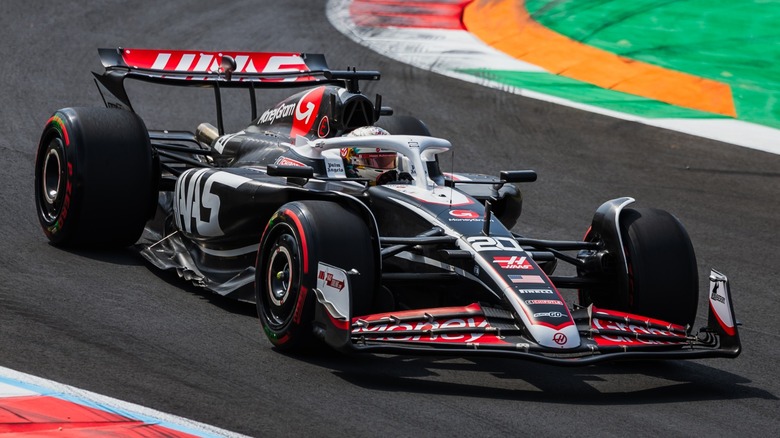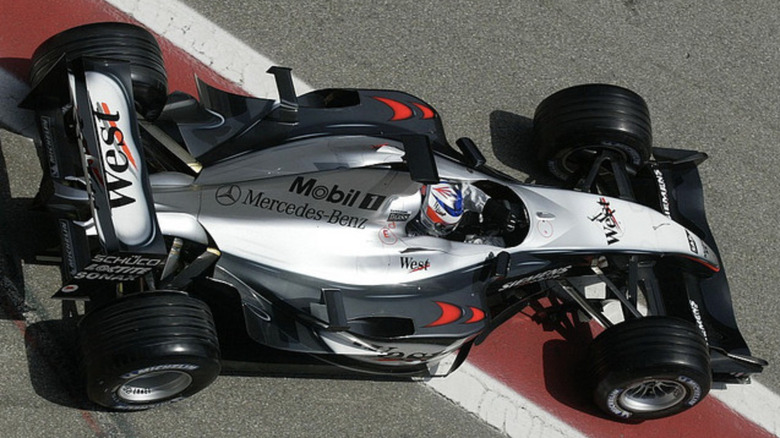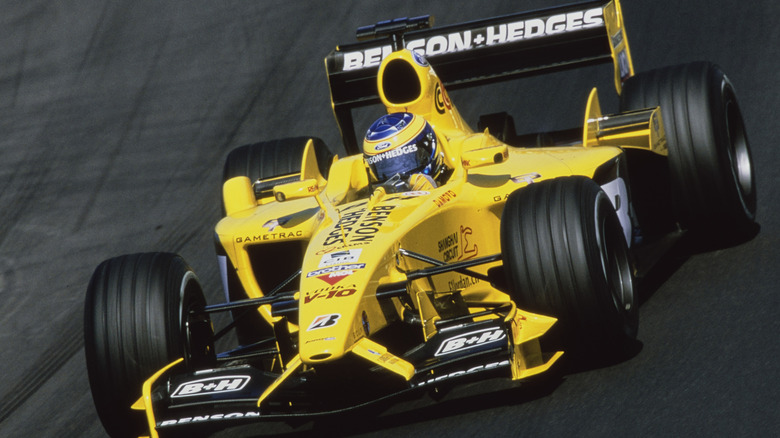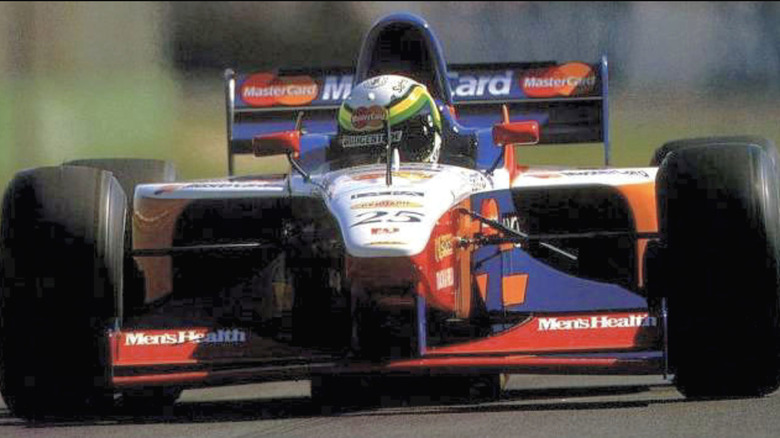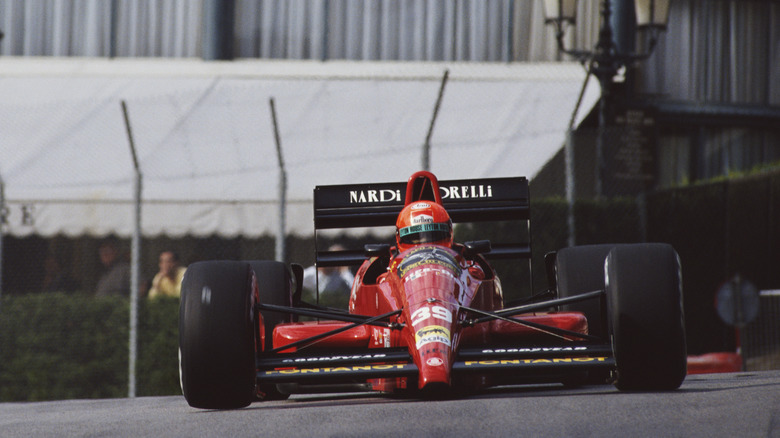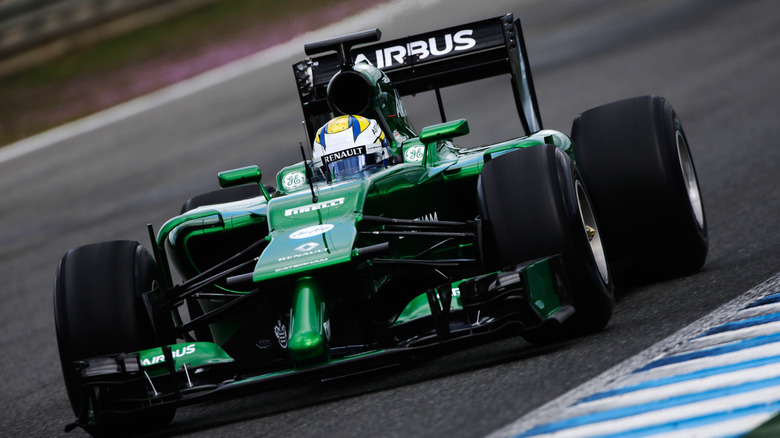5 Of The Worst F1 Cars In History
The 1955 Le Mans disaster is considered by and large as one of the worst crashes in Formula 1 racing history. On June 11th on the Circuit de la Sarthe driver Lance Macklin swerved out in front of Pierre Levegh's Mercedes 300 SLR, causing the latter to lose control of the vehicle, careen over the protective barriers at about 125 miles per hour, and subsequently explode in the stands — resulting in the deaths of 77 spectators including Levegh. Since this horrendous incident, Formula 1 has experienced much growth in the advancement of safety procedures to protect the well-being of audiences and competitors alike. While a repeat of the 1955 disaster is unlikely, the industry is still not immune to poor performances from low-grade race-cars or their subsequent spin-outs and collisions that come at a very high price.
The term "formula" in Formula 1 denotes a set of strict, clearly defined regulations from the Fédération Internationale de l'Automobile ("FIA") that all competitors must abide by concerning the components and specifications when designing a compliant race car. While these comprehensive recipes have led to some incredible engineering and technology advancements, particularly the high-performance engines that have gone on to power non-F1 commercial cars, there have also been cases of subpar construction and design that have led to a less-than-stellar crossing of the finish line. From the spontaneous combustions of the McLaren MP4-18 to the painfully slow speeds of the Lola T97/30, here is a look at some of the worst vehicles to compete in the F1 championships.
The McLaren MP4-18 lit up the racetrack, literally
Our first stop is with a race car that actually never even made it through the rigorous, three-stage qualification process for the Formula 1 championship because of the number of severe technical issues it encountered. In 2002, the McLaren MP4-18 was constructed by the company's chief designer, Adrian Newey, in the hopes of finally launching an inventive contender to successfully face down rising competitor Ferrari on the world stage. On the outside, the MP4-18 had an aggressive and edgy style, complete with a radically streamlined body that was considered revolutionary for the industry at the time.
However, the unconventional design of the MP4-18 may have landed too far outside the box for racing purposes. The car was plagued by a series of chronic issues ranging from a very sensitive and fickle carbon composite gearbox to frequent spin-outs and crashes. A flawed sensor kept raising problems with the hydraulics, and the exhaust system was so badly compromised that it would cause the car to combust — sometimes even before it entered the track. McLaren only produced four units of this fiery race-car for testing, half of which were completely totaled when undergoing testing by drivers Alexander Wurz and Kimi Raikkonen, who, after getting out of the wreck, firmly stated, "I am never driving that car again."
The MP4-18 also suffered from the consequences of poor management decisions. When Newey presented a series of enhancements for the MP4-18 in 2004 to improve safety and quality of performance, such as reconfigured chassis for improved aerodynamics, the managing director Martin Whitmarsh and the majority of the team instead opted to forego corrections and keep the original design. Newey later executed these new concepts throughout his tenure working for Red Bull after departing from McLaren.
[Featured image by BYSER via Wikimedia Commons | Cropped and scaled | CC BY 2.0]
The one-track winning legacy of the Jordan EJ13
A year after the McLaren MP4-18's failure to make it off the test track, the EJ13 would score an underdog victory at the 2003 Brazilian Grand Prix driven by Giancarlo Fisichella. While the team may have been owned by Irish businessman and TV personality Eddie Jordan, the team struggled to secure adequate funding, which led to reliance on cheaper, less stable components for the race car. At one point, the team alternated the EJ13's Honda engine for the Ford V10, which quickly proved incompatible with the make-up of the vehicle because if the motor wasn't catching fire, it was puttering along at mediocre speeds. The car's design also wasn't adaptable to change and didn't respond well to adjustments by the technicians, leading to very poor showings in the Australian and Malaysian races.
So, given the subpar parts used in the development of the EJ13, how was it able to come from the bottom of the pack and secure its miraculous victory? A lot of the Jordan team's success comes down to severe rainy conditions that resulted in six drivers spinning out at turn three due to a broken drain cover. After that, it was a domino effect as more competitors lost control and spun out, while Fisichella continued to wage a strategy of attrition to see how many other competitors they could outlast. Ironically, the EJ13 ended up catching fire in the pit after Fisichella successfully crossed the finish line, which would serve as the perfect metaphor for the team's trajectory after its first and only victory.
The Lola T97/30 was disqualified due to slow speeds
In contrast to Jordan scrounging for finances to keep their race car afloat, Lola appeared to be flush with cash in the late nineties, given its estimated $45 million budget courtesy of join sponsors MasterCard and Pennzoil. In fact, Lola's sponsors were so eager to compete that they pushed the entire team to compete in 1997, which was a year prior to their scheduled launch so that they would have enough time to thoroughly test the T97/30. With a timeframe of only four months Lola scrambled to assemble a competent team while also reconfiguring the layout of components like the suspension on the fly. More importantly, unlike previous models, the Lola T97/30 was developed purely via computer-aided design ("CAD") and never saw the inside of a physical wind tunnel to test speed aerodynamics.
In the end, neither of the Lola T97/30 race-cars driven by Vincenzo Sospiri and Ricardo Rosset qualified at the 1997 Australian Grand Prix due to issues with downshifting and the engines' abysmal power. With the pole time set at 1:29.369 both cars set a time with roughly an 11 to 13-second difference, meaning that neither vehicle qualified under the F1's rule where all competitors need to set a Q1 time within 107% of the leading contender. The final nail in Lola's track record for the season came shortly thereafter when MasterCard pulled their sponsorship of the organization just before they were to enter into the Brazilian championship.
[Featured image by Sporti via Wikimedia Commons | Cropped and scaled | CC BY 2.0]
The Life F190 tried to do too much with too little
In 1990, the Italian Life F1 racing team made its debut around the same time that regulations were revamped to prohibit the use of turbocharged engines. In response to this, the team's engineer, Franco Rocchi, developed a customized W12 engine with three banks of four cylinders so that, in theory, the engine would generate the power of a twelve-cylinder. The engine was then placed atop an old chassis purchased from the discontinued First Racing team that failed to qualify for the F1 in 1989.
Unfortunately, this heavily reconfigured engine only produced a maximum of 375 bhp according to estimates, which was a good 300 units less than the average for the time. Not only did Life F190 fail to even succeed at the Formula 1 pre-qualification round, but the racer also failed to complete a single lap at the Brazilian championship resulting in the departure of racer Gary Brabham. On average, the race car performed 40 miles per hour slower than the other competitors when handling the speed traps at the Hockenheimring competition.
The Life team quickly came to the consensus that the W12 engine was not performing up to racing standards. So, the team decided to switch out the motor with the Judd V8 in order to enhance speed. However, it quickly turned out that the body of the F190 was designed for the proportions of the Judd V8 when the cover flew off when driver Bruno Giacomelli attempted the first turn at the Portugal championship. After that, the team owner, Ernesto Vita, decided to forego any more championships and cut his losses by disbanding the team.
The Caterham CT05 ranks as both one of the slowest & ugliest racers in Formula 1 history
2014 marked a transitional time period in Formula 1 history because, for the first time, the season would feature a rollout of race cars sporting brand-new, regulation-approved turbo-hybrid engines. In the midst of this time of change, Malaysian businessman Tony Fernades was determined to make a change and acquired the Caterham Racing Group. Prior to this point, Fernades owned Lotus Racing, which had been giving a passable yet mediocre performance during the early '10s seasons.
However, because the new regulations permitted hybridized engines, the nose-cones on Formula 1 vehicles were whittled and reduced significantly out of precaution for the driver's safety. The result was a new line of aesthetically unappealing racers, of which the Caterham CT05 was by far the ugliest. In fact, because the team had inadequate funds to invest in quality design, they painted the front black in an attempt to hide the unfinished portions of its silhouette from the public onlookers. The Caterham CT05 was also incredibly slow, with neither of its drivers, Marcus Ericsson and Kamui Kobayashi, scoring zero points and unable to break any higher than 11th place during the 2014 season.
The team tried to rally and gave the CT05 a total makeover to reduce the unsightly, slap-dash design, but sadly, the attempt was too little too late. Like many of the other vehicles in this list, the Caterham CT05 was not immune to chronic defects and mechanical failures, particularly with the suspension. During a race in Sochi, problems flared up with the suspension, and because there was no replacement part, the team instead wrapped it in carbon as a temporary band-aid, leaving then-driver Kobayashi deeply uneasy. The Caterham Group soon disbanded at the end of the 2014 season due to a lack of finances, although it did make an appearance at the season finale due to an atypical crowdfunding attempt.
